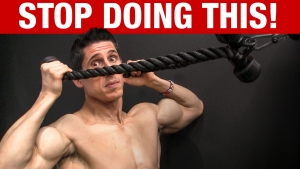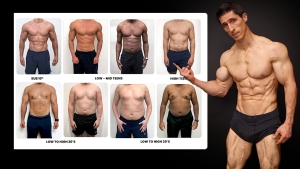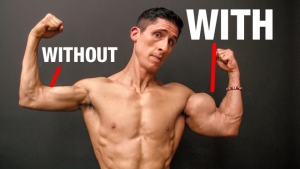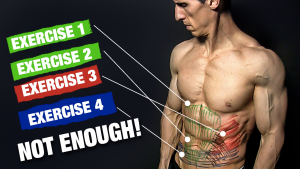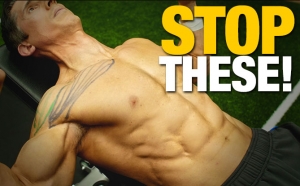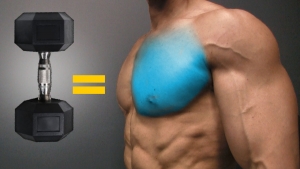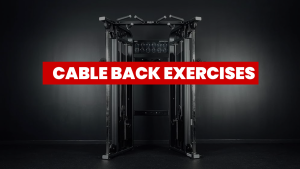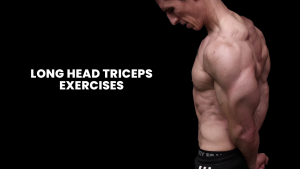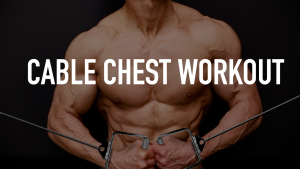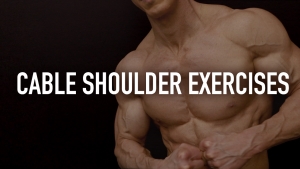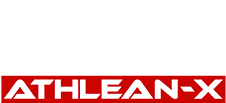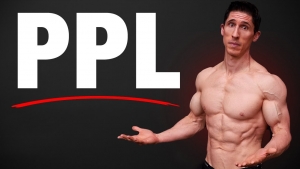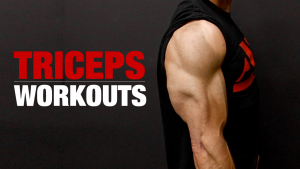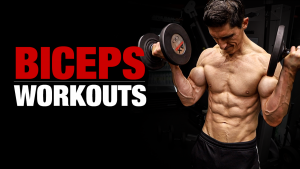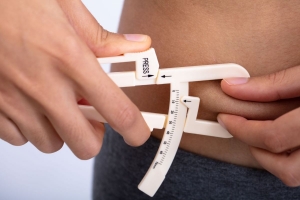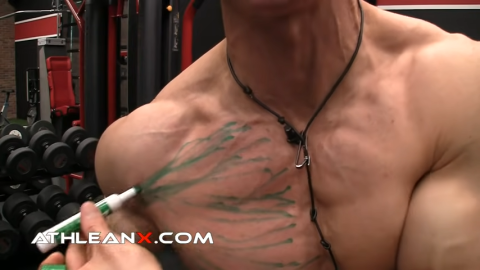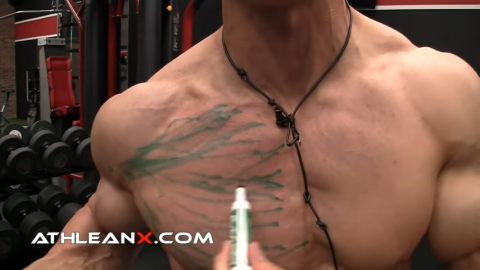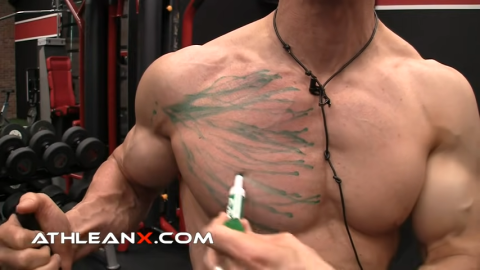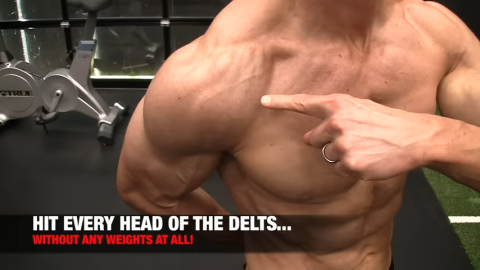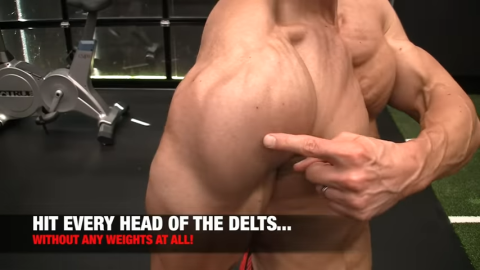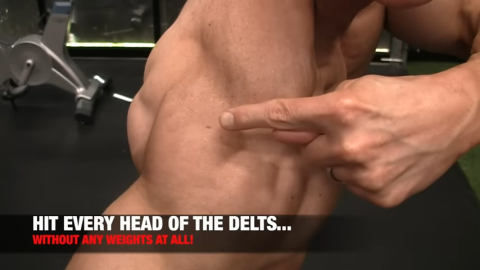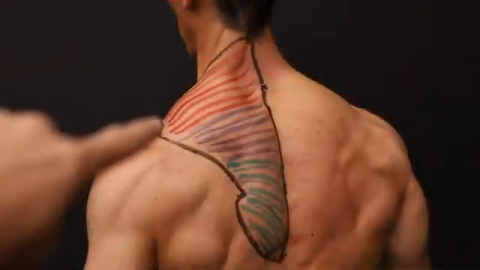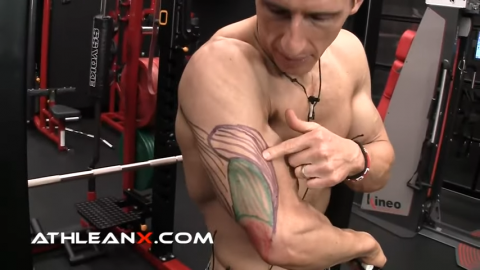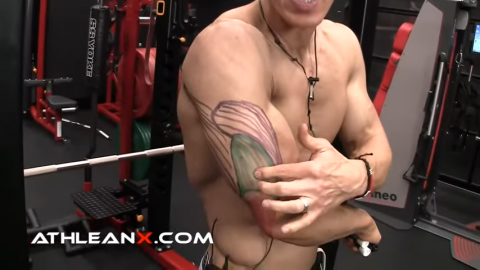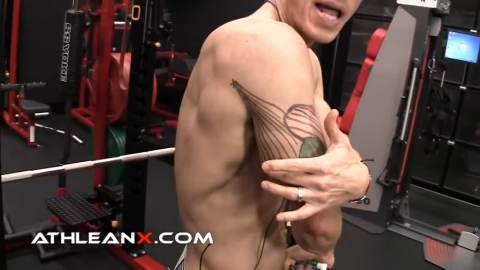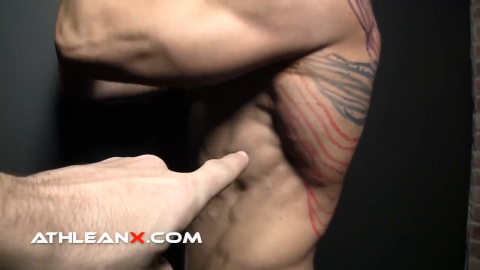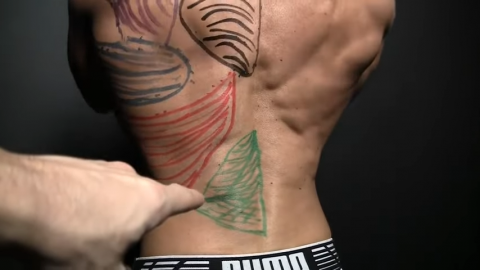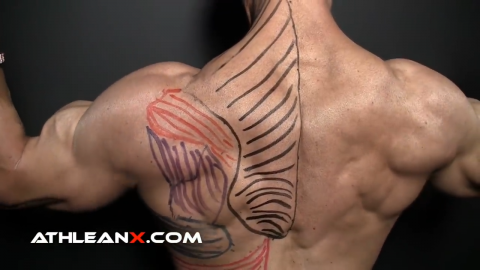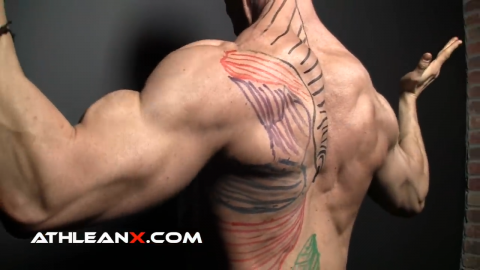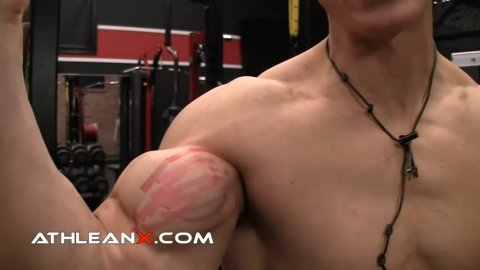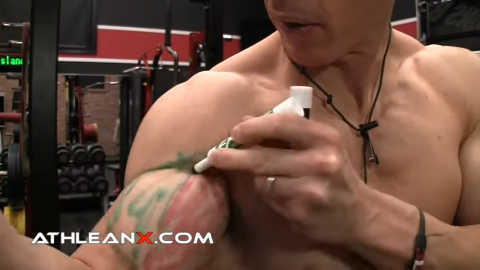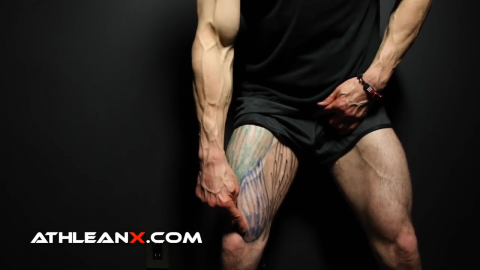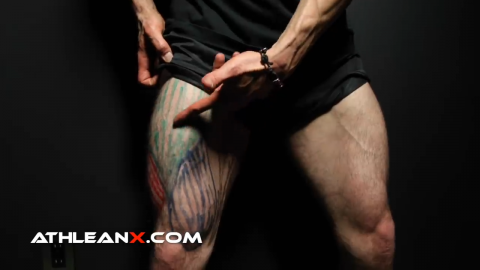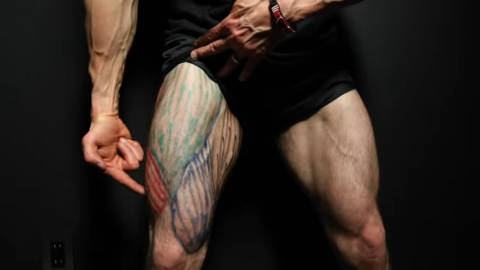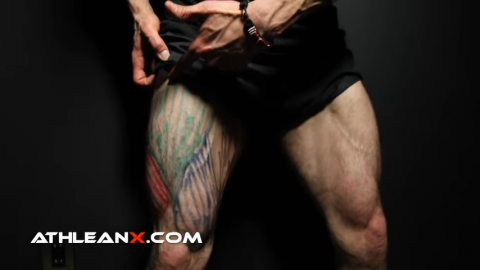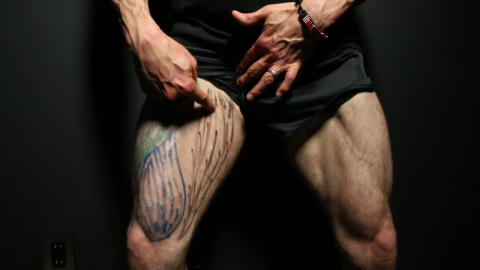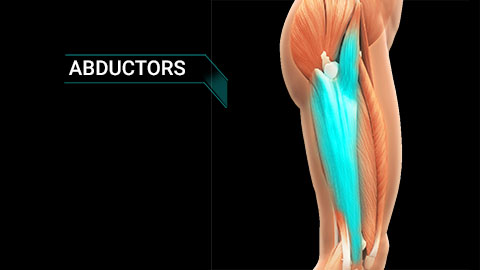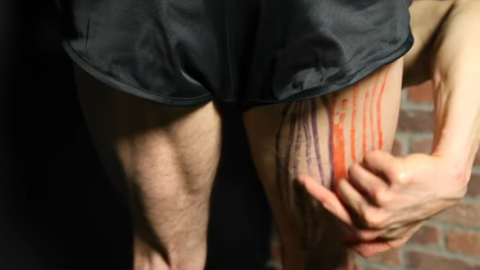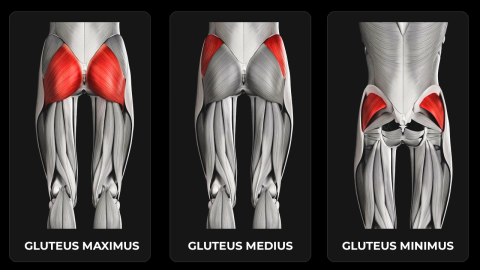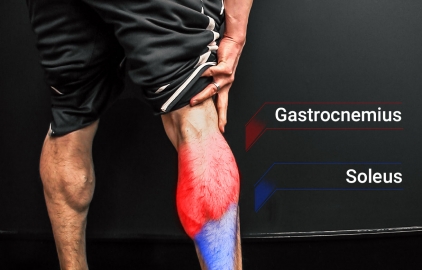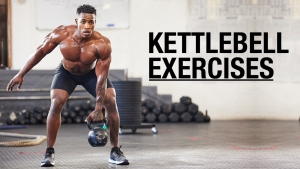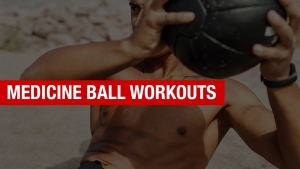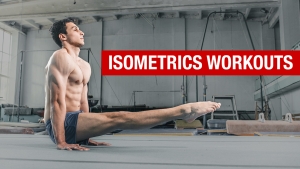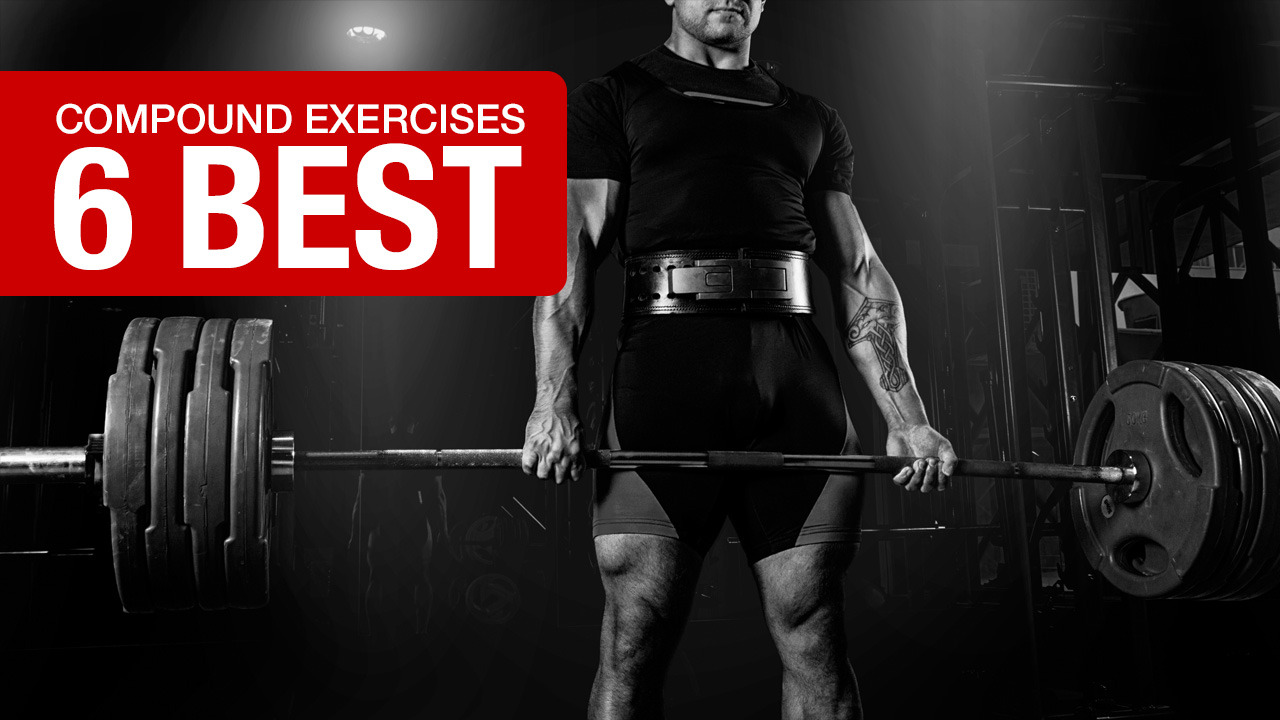
WHY COMPOUND EXERCISES ARE IMPORTANT
Guys, if you’re serious about getting stronger, building muscle, and transforming your body, then you need to know this:
Not all exercises are created equal.
Some movements give you way more bang for your buck, and those are the compound exercises.
These aren’t just your average lifts—they’re the cornerstone of any effective exercise routine.
By hitting multiple muscle groups at once, compound exercises maximize your results in less time.
Ready to build your arsenal?
Here are the 6 best compound exercises you need to dominate in the gym and take your gains to the next level.
COMPOUND EXERCISES AND BUILDING STRENGTH
I want to show you how to get stronger, and I mean fast.
This isn’t just about making gains; it’s about maximizing your workout routine to get the best results in the shortest space of time.
But before we dive in, let me make one thing clear:
This isn’t going to be complicated, but it’s definitely not easy. The hard work you’ll need to put in won’t be a walk in the park, but the approach is simple.
The fastest way to build muscle mass and strength?
Two things: Compound exercises and progressive overload.
Compound exercises should be the foundation of your workout routine. Why?
Because compound exercises involve multiple muscle groups working together in multi-joint movements, which means you can move more weight, activate more muscle fibers, and build more strength.
When you combine that with progressive overload—constantly challenging your muscles with heavier weights—you’ve got a recipe to aid in muscle growth and functional strength.
Here’s the beauty of compound exercises: these two principles go hand in hand.
Because you’re engaging multiple muscles in compound lifts, you can push more weight, which allows you to progressively overload those muscles more effectively, leading to maximal muscle hypertrophy.
Now, there will come a time when you hit plateaus, but if you’re just starting out, compound exercises are your ticket to rapid strength gains and muscle development.
Exercises like the Barbell Back Squat, Bench Press, and Deadlift are prime examples of movements that engage the entire body and promote intramuscular coordination.
But—and this is a big but—don’t make the mistake of chasing numbers and neglecting your form.
It’s not just about lifting heavy; it’s about lifting right.
If you focus only on the weight and ignore the quality of your movement, you’ll end up with cracks in your foundation that are hard to fix later on.
Maintaining a neutral spine and proper knee alignment, for example, are crucial to avoiding injury and ensuring long-term gains. Building strength on top of a weak foundation is a recipe for disaster.
Why are compound exercises so effective for building strength and muscle?
Because they allow you to load up the weight. Take a movement like the Bench Press—your triceps brachii, shoulders, and pectoralis major all work together to move the bar.
Each muscle has its own strength capacity, but when they work together, their combined strength is far greater than what any one muscle could achieve on its own. This is why isolation exercises aren’t the best way to build strength—at least not initially.
For beginners, especially those who want to get strong quickly, focus on compound movements.
As you progress, you can start addressing individual muscles with isolation movements to enhance overall strength and correct any muscle imbalances.
But remember, the foundation is built with compound lifts and progressive overload. Stick to that, and you’ll see the results.
COMPOUND EXERCISES: MUSCLES WORKED
When it comes to maximizing your gains with compound exercises, it’s not just about moving the weight—it’s about feeling every single muscle engage.
The mind-to-muscle connection is crucial in ensuring that you’re not only lifting efficiently but also targeting the right muscles to get the most out of each movement.
By consciously focusing on the muscles being worked, you can enhance muscle activation, improve your form, and ultimately see better results from your efforts.
Let’s review the major muscle groups in the body based on how I set up my own compound exercise training programs:
- Push (Vertically)
- Push (Horizontally)
- Pull (Row)
- Pull (Vertical Pull)
- Lower Body (Anterior Chain)
- Lower Body (Posterior Chain)
PUSH
When it comes to the “Push” category, we’re focusing on the muscles that drive movements away from your body, like pressing a barbell overhead or performing a Push-Up.
These exercises recruit multiple muscle groups, including your chest, shoulders, and triceps, working together in a coordinated effort.
Mastering the mind-to-muscle connection here is key to maximizing the strength and size gains from each push movement.
UPPER CHEST
The fibers in your upper chest start at the clavicle, right near your shoulders, and run diagonally down toward your humerus, connecting upward from the center of your chest.
MID CHEST FIBERS
The mid-chest fibers kick off from the sternum and stretch straight across your chest.
LOWER CHEST FIBERS
As for the lower chest fibers, they start at the base of the sternum. From here, it angles down and inward, meeting at the center of your chest.
SHOULDERS: FRONT DELT
The front delt fibers originate from the clavicle and run down toward the humerus, helping to lift your arm forward and overhead.
SHOULDERS: MIDDLE DELT
The middle delt fibers start from the acromion of the scapula and extend outward to the humerus. They are necessary for raising your arm out to the side and creating that broad shoulder look.
SHOULDERS: REAR DELT
The rear delt fibers begin at the spine of the scapula and run diagonally down to the humerus, essential for pulling your arm back and improving shoulder stability.
UPPER TRAPS
The upper traps are crucial for shrugging your shoulders, lifting your arms overhead, moving your neck, and maintaining good posture by keeping your shoulders back and neck straight.
TRICEPS: LATERAL HEAD
The lateral head of the triceps originates from the upper humerus and extends down to the elbow, playing a key role in extending the forearm and adding width to the upper arm.
TRICEPS: MEDIAL HEAD
The medial head of the triceps starts from the lower humerus and runs down to the elbow, helping to extend the forearm while providing stability during pressing movements.
TRICEPS: LONG HEAD
The long head of the triceps originates from the scapula and extends down to the elbow, playing a vital role in both extending the forearm and stabilizing the shoulder during pressing and overhead movements.
The latissimus dorsi – or the lats, for short – spans from the lower spine and pelvis up to the humerus. It assists with pulling movements and contributing to the width of your back.
UPPER AND LOWER TRAPS
The upper and lower traps extend from the base of the skull and upper spine down to the scapula. They help with shoulder elevation, depression, and stabilizing the scapula during various pulling and lifting movements.
LOW BACK / ERECTOR SPINAE
The erector spinae muscles run along the spine from the lower back to the upper vertebrae. They are necessary for extending the spine, maintaining posture, and stabilizing the back during lifting and bending movements.
ROTATOR CUFF
The rotator cuff muscles originate from the scapula and attach to the head of the humerus. They are key for stabilizing the shoulder joint and allowing for a wide range of arm movements.
TERES MAJOR
The teres major extends from the lower scapula to the humerus, playing a role in adducting and rotating the arm inward, as well as stabilizing the shoulder during pulling movements.
SHORT HEAD (INNER BICEPS)
The short head of the biceps originates from the scapula and runs down the inner arm to the radius, flexing the elbow and assisting in supination of the forearm.
LONG HEAD (OUTER BICEPS)
The long head of the biceps starts from the scapula and travels down the outer arm to the radius. It assists with elbow flexion while adding peak to the biceps during arm curls.
BRACHIALIS
The brachialis sits beneath the biceps, originating from the humerus and attaching to the ulna. It’s needed for flexing the elbow and adding thickness to the upper arm.
LOWER BODY (ANTERIOR CHAIN)
The lower body (anterior chain) section focuses on the front-facing muscles of lower-body compound exercise, which are crucial for movements like squatting, lunging, and running.
These muscles not only power your legs but also play a vital role in stabilizing your body and maintaining proper posture during lower body exercises.
VASTUS MEDIALIS
The vastus medialis is the inner part of your quad, right by the knee, and its main job is to drive knee extension.
VASTUS INTERMEDIUS
The vastus intermedius sits beneath the middle of your quad, hidden from view, and it helps extend the knee.
VASTUS LATERALIS
The vastus lateralis is the outer part of your quad, running along the outside of the knee, and it’s necessary for powering knee extension.
RECTUS FEMORIS
The rectus femoris is the only quad muscle that attaches above the hip, giving it the unique role of helping with both knee extension and hip flexion.
ADDUCTORS
The adductor muscles run along the inner thigh from the pelvis to the femur, essential for bringing the legs together and stabilizing the hips during lower body movements.
ABDUCTORS
The abductor muscles, located on the outer hips, extend from the pelvis to the femur. They help to move the legs away from the body and stabilize the hips during lateral movements.
LOWER BODY (POSTERIOR CHAIN)
The lower body (posterior chain) section is all about the muscles that run along the back of your body, from your glutes down to your calves.
These muscles are critical for explosive movements, like sprinting and jumping, as well as for maintaining a strong, stable posture.
BICEPS FEMORIS
The biceps femoris, part of the hamstrings, runs from the pelvis down to the fibula. It’s needed for knee flexion and hip extension during lower body movements.
SEMITENDINOSUS
The semitendinosus, part of the hamstrings, extends from the pelvis to the tibia, playing a key role in knee flexion and hip extension, and aiding in stabilizing the leg during movement.
GLUTEUS MAXIMUS
The gluteus maximus is the largest and most familiar of the glute muscles, responsible for hip and thigh movement, maintaining an upright posture, and providing shape to the butt, making it essential for activities like standing, climbing, and running.
GLUTEUS MEDIUS
The gluteus medius, the second largest glute muscle, is important for stabilizing the pelvis during movement and assists in hip abduction, located beneath the gluteus maximus on the outer side of the hip.
GLUTEUS MINIMUS
The gluteus minimus, the smallest and deepest of the glute muscles, stabilizes the pelvis during movement and assists in hip abduction and inward thigh rotation, despite being hidden beneath the gluteus maximus and medius.
GASTROCNEMIUS
The gastrocnemius is the largest and most visible calf muscle, known for its bulging appearance, with two heads (medial and lateral).
It’s responsible for pushing off the ground during activities like running, jumping, and walking, especially when the knee is straight.
SOLEUS
The soleus, located beneath the gastrocnemius, is a flatter muscle that’s most active when the knee is bent, playing a key role in foot plantar flexion, helping with standing, walking, and running.
6 BEST COMPOUND EXERCISES
When it comes to building strength, increasing muscle size, and improving overall fitness, I’d argue that nothing beats compound exercises.
These movements target multiple muscle groups at once, allowing you to get the most out of your workout in the least amount of time.
Whether you’re aiming to pack on muscle, improve functional strength, or simply enhance your athletic performance, the best compound exercises should be the foundation of your training routine.
Let’s dive into the top compound lifts that will deliver the biggest bang for your buck.
I’ll break this list of compound exercises down according to the following categories:
- Push (Vertically)
- Push (Horizontally)
- Pull (Row)
- Pull (Vertical Pull)
- Lower Body (Anterior Chain)
- Lower Body (Posterior Chain)
PUSH (VERTICALLY)
A quick reminder: with this category, we’re dialing in on the muscles responsible for driving weight away from your body, specifically in a vertical fashion.
And for that, we go to the traditional Overhead Press.
OVERHEAD PRESS

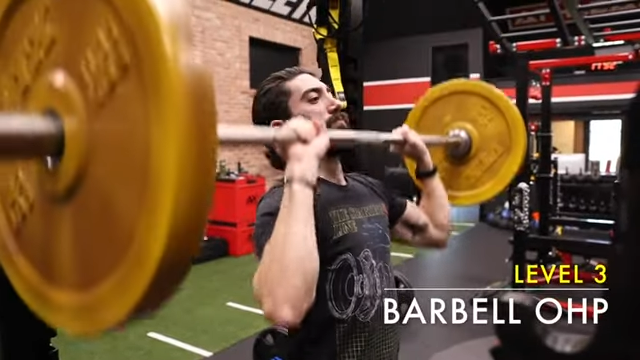
HOW TO DO THE BARBELL OVERHEAD PRESS:
- Start by standing with your feet about shoulder-width apart in a stable position, facing a heavy barbell set at chest height in a power rack.
- Using an overhand grip, hold the barbell just outside shoulder-width, and step back until the bar is aligned with your shoulders.
- Engage your abs and lats, and drive through your feet using leg power to press the barbell directly overhead.
- Keep your forearms vertical with a slight forward angle, allowing your head to move through as you press up.
- Lower the bar slowly back down to the starting position at shoulder height.
WHAT MAKES IT EFFECTIVE: The Overhead Press is an awesome compound move that hits your shoulders, triceps, and abdominal muscles all at once, building serious upper body strength while improving shoulder stability and mobility—it’s a must-have in your training arsenal.
PUSH (HORIZONTALLY)
On the other side of the “push” category, we focus on the muscles that help to push the weight away from you but in a horizontal plane.
Naturally, we want to do this classic exercise: the Barbell Bench Press.
BENCH PRESS

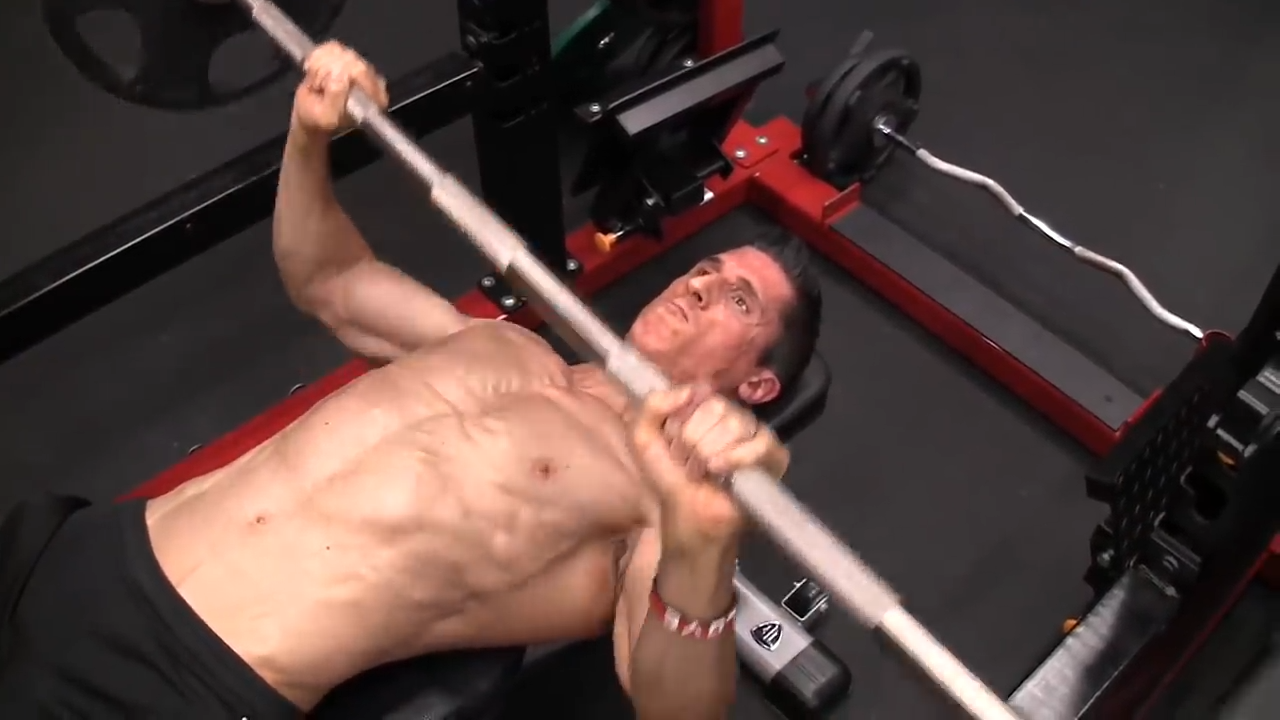
HOW TO DO THE BARBELL BENCH PRESS:
- Start by sitting on the flat bench and aligning your eyes directly under the bar. Your head should be positioned on the bench with a neutral spine, not pressing back into the bench.
- Make sure your shoulders are pulled down and together to create a stable foundation for the lift, avoiding any shrugging.
- As you lie back, place your feet flat on the ground, with each foot directly under each knee, and engage your glutes to generate maximum force during the lift.
- Grip the bar with your hands just wider than shoulder-width apart, wrapping your thumbs around the bar for a secure grip. Ensure the bar sits low in your hands, supported by your forearms.
- As you lift off, your elbows should be at about a 75-degree angle from your body, not flared out, to protect your shoulder joints.
- Lower the bar to your lower chest with control, keeping your shoulder blades retracted, then press the bar back up following a slight diagonal path toward the starting position.
- Throughout the movement, keep your core tight to maintain stability and prevent energy leaks.
WHAT MAKES IT EFFECTIVE: The Barbell Bench Press simultaneously targets multiple upper body muscles, including the chest, shoulders, and triceps, maximizing strength and muscle gain in one movement.
PULL (ROW)
Now, we start focusing on your posterior chain with pulling movements.
The first type of pulling exercise is one that allows you to perform a rowing motion.
What better compound exercise for that than the Bent Over Barbell Row?
BARBELL ROWS

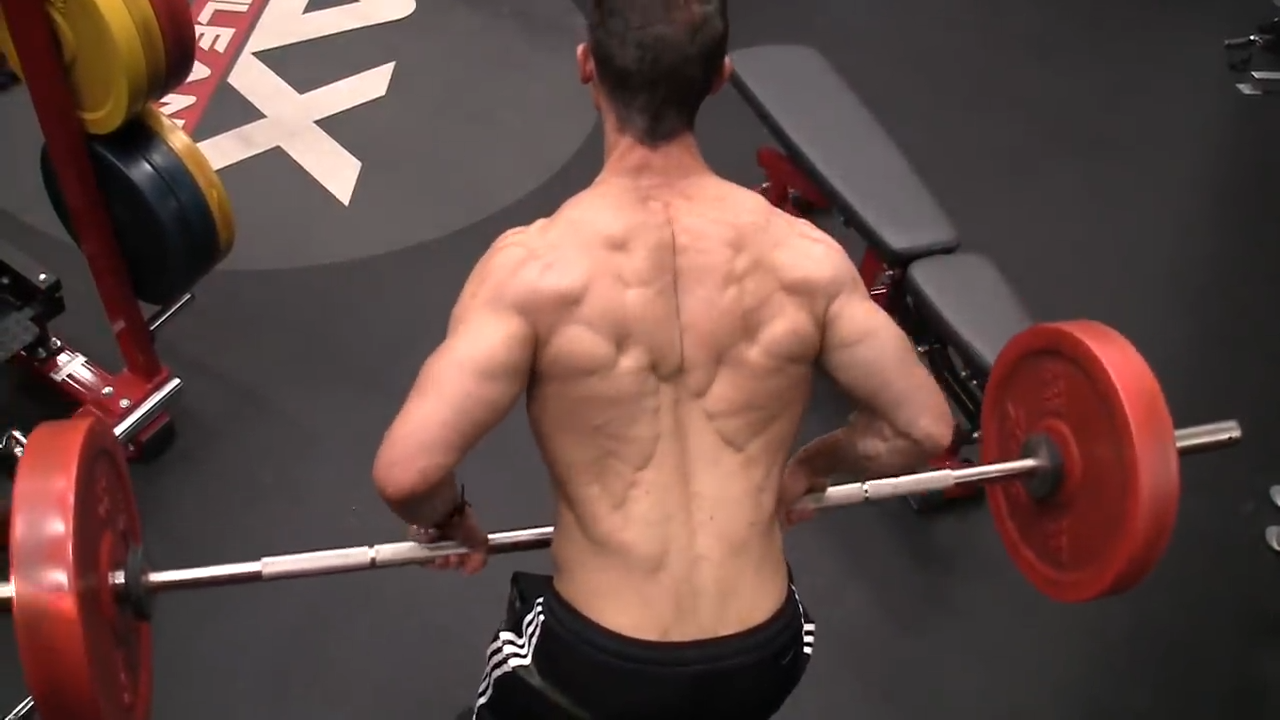
HOW TO DO THE BARBELL ROW:
- Start by loading up a barbell on the floor or in a rack set just below knee height.
- Step up to the bar with your feet about hip-width apart, and grab it with an overhand grip, slightly wider than shoulder-width.
- Now, hinge at the hips, keeping a slight bend in your knees, and lower your torso to about a 45-degree angle—not parallel to the floor.
- Keep your back flat and your core tight. You want your lats, not your lower back, doing the heavy lifting.
- As you pull the bar toward your lower chest or upper abs, drive your elbows back, keeping them close to your body. Don’t flare them out—this is how you maximize lat engagement and protect your shoulders.
- Squeeze your shoulder blades together at the top of the movement, then slowly lower the bar back to the starting position, making sure to maintain control and keep your form tight.
- Remember, this isn’t about yanking the bar up with momentum—it’s about controlled, powerful pulls that target your back muscles while keeping your entire body stable and safe.
- Focus on keeping your triceps engaged at the bottom to keep your biceps from taking over, letting your lats do the work.
WHAT MAKES IT EFFECTIVE: The Barbell Row is a compound move that not only builds a thicker, stronger back but also boosts your overall pulling power, enhances core stability, and improves your athletic performance by reinforcing proper hip hinge mechanics.
PULL (VERTICAL PULL)
The other type of pulling movement you want to focus on is one that allows you to pull weight vertically.
In this case, your own body weight.
Here’s the go-to Pull-Up.
PULL-UPS

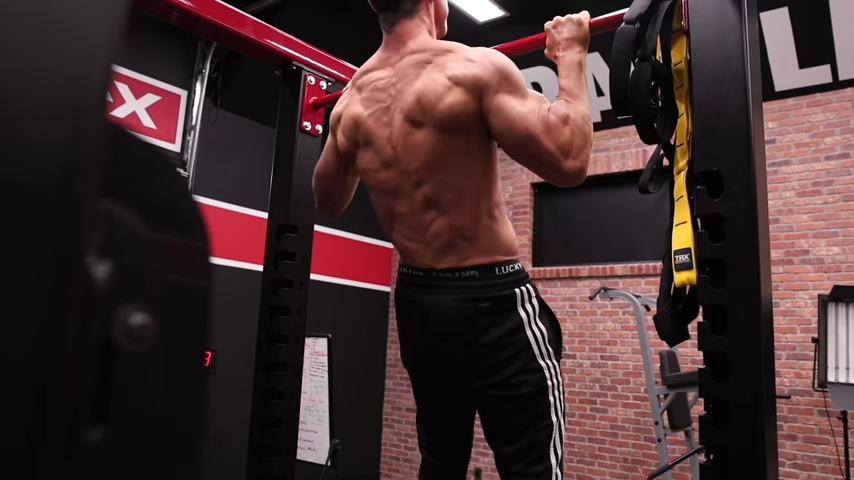
HOW TO DO THE PULLUP:
- Start by grabbing the pull-up bar with an overhand grip (pronated) just outside shoulder width. This optimal position ensures your elbows stay in front of your body, your shoulder blades are drawn back, and your lats are primed for the pull.
- Avoid a shallow hook grip. Instead, grip the bar deep in your palms with your thumbs wrapped over your fingers. This reduces strain on your finger flexors and elbows, setting you up for long-term success.
- Instead of bending your knees and curling your feet behind you, extend your legs slightly out in front of you in a hollow position. This helps eliminate energy leaks, making your Pull-Ups more efficient.
- Look up at the bar, focus on squeezing the bar through your ring and pinky fingers, and initiate the pull by thinking of bringing the bar down to your chest. This engages your lats and helps with thoracic extension, which protects your shoulders.
- As you pull, think about attacking the bar with your chest. This will help you maintain thoracic extension, making the movement easier and safer for your shoulders.
- At the bottom of each rep, engage in a proper dead hang by keeping your shoulder blades down and back, avoiding the common mistake of letting your shoulders rise toward your ears. This stabilizes your shoulders and prevents injury.
WHAT MAKES IT EFFECTIVE: The Pull-Up is more than just an upper body strength builder; it’s a versatile bodyweight exercise that enhances grip strength, improves shoulder stability, and engages the core for better body control.
LOWER BODY (ANTERIOR CHAIN)
Let’s move to the lower body.
In particular, we’re going to focus on the major muscle groups on the front of your lower body.
To target these muscles, we’ll use the tried-and-true Barbell Back Squat.
BARBELL BACK SQUAT

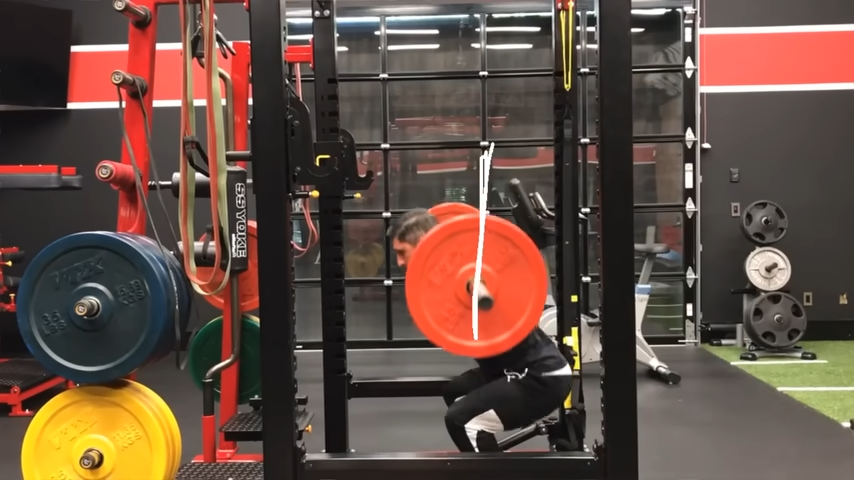
HOW TO DO THE BARBELL BACK SQUAT:
- Step under the barbell and stand with your feet shoulder-width apart.
- Make sure your entire foot is flat on the ground—no lifting your heels or balls of your feet.
- Position the barbell across your traps (upper back muscles), not your neck. Flex your traps to create a comfy shelf for the bar.
- Keep your head in a neutral position—look straight ahead with your head neutral, not up or down.
- Lean slightly forward but keep your back straight. Your upper back (thoracic spine) should be upright to keep you stable.
- As you lower into the squat, push your knees outward. Avoid letting them collapse inward.
- If your knees tend to cave in, try using a resistance training band around your knees to help train them to stay in position.
- Keep your elbows tucked in close to your body. This helps engage your traps and keeps the bar stable.
- Think “Superman”—chest up, shoulders back. This helps keep your upper back stable and supports the squat movement.
- Make sure your feet are aligned with your toes slightly pointed out. This gives you a solid base and helps with movement mechanics.
- Pause at the bottom of the movement then press through the lower body to return to the initial starting position.
WHAT MAKES IT EFFECTIVE: The Barbell Back Squat is an effective exercise because it engages multiple major muscle groups simultaneously, improving overall strength, power, and stability while enhancing fundamental movement patterns.
LOWER BODY (POSTERIOR CHAIN)
Last, but not least, we turn to the back of your lower body.
To go after these muscles, there’s nothing quite like the Barbell Deadlift.
DEADLIFT

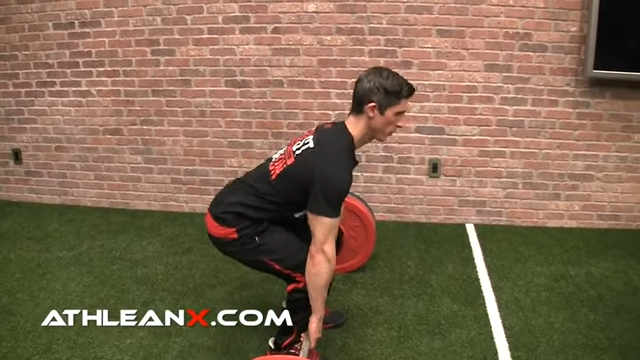
HOW TO DO THE DEADLIFT:
- Stretch the adductors, engage the hamstrings and pelvis, and practice a few hip hinges.
- Start in a standing position. Place your feet hip width apart and grab the barbell with an overhand grip for beginners or with a hook grip if you are more advanced and prefer it. Position your hands at a width of about one inch outside of your feet, ensuring you have a balanced load.
- Before you lift, focus on elevating your chest, pulling your shoulders back, flattening your shoulder blades, and lowering your hips. Also, keep your core tight. Be sure your back is NOT rounded.
- Push your chest forward, squeeze your shoulder blades, engage your arms, and lower your hips. Drive through your legs while pulling the bar upward, keeping it close to your shins until it reaches knee height.
- Once you reach knee level, drive through using the strong muscles of the hips. You’ll also use your low back extensors and traps to stabilize the bar. Drive your hips forward and bring the barbell to hip height until you are in an upright position.
- Return to the starting position by reversing the hip hinge movement until the bar reaches your knees, and then performing a straight knee bend until the bar reaches the ground.
WHAT MAKES IT EFFECTIVE: The Deadlift is an excellent compound exercise because it engages multiple major muscle groups— including the back, glutes, hamstrings, and core—while building raw strength and enhancing functional movement patterns.
COMPOUND EXERCISES: COMMON MISTAKES
When it comes to compound exercises, mastering proper form is crucial for maximizing muscle growth, improving movement efficiency, and avoiding injury.
These key lifts are foundational to any effective workout routine, but they’re also where most mistakes happen.
Let’s dive into the most common mistakes that can sabotage your gains and how to correct them to get the biggest benefit from your workout.
OVERHEAD PRESS
The quintessential “boulder shoulder” builder is easy to mess up if you aren’t careful. Here are the most common mistakes for the Overhead Press:
Overarching the Back: Overarching the back during the Overhead Press is a sign that your core isn’t fully engaged, putting your spine at risk. To correct this, keep your core tight and your glutes engaged, maintaining a neutral spine throughout the movement. This not only protects your lower back but also enhances the effectiveness of the lift by ensuring proper alignment.
Elbows Flaring Out: Flaring the elbows out can destabilize the lift and place unnecessary stress on the shoulder joints. Keep your elbows slightly in front of the bar, ensuring a straight bar path overhead. This improves shoulder stability and allows for a more controlled movement.
Pressing Too Far Forward: If you’re pressing the bar too far forward, you’re not maximizing the benefits of this compound exercise. The bar should travel in a straight line over your head, allowing your head to move slightly back as the bar clears your face, then forward again as you complete the lift. This movement pattern ensures proper shoulder engagement and reduces the risk of injury.
BENCH PRESS
The Bench Press is a staple upper body exercise for building chest, shoulder, and triceps strength, but it’s also one where small mistakes can lead to big problems.
To get the most out of your Bench Press and stay injury-free, it’s crucial to avoid these common pitfalls.
Flared Elbows: Flaring your elbows out wide during the Bench Press places undue stress on the shoulder joints and can lead to injury. Keep your elbows tucked at about a 75-degree angle from your body to protect your shoulders and maximize pectoralis major muscle activation. This position also allows for a smoother bar path and better control throughout the lift.
Lack of Leg Drive: Many lifters forget to engage their legs during the Bench Press, missing out on the full-body exercise benefits of this upper body exercise. By planting your feet flat on the ground and driving through your legs, you create a stable base that supports the lift, enabling you to push more weight with better control.
Poor Bar Path: A common error is pressing the bar straight up, which can strain the shoulders and reduce the lift’s effectiveness. The ideal bar path is slightly diagonal—lower the bar to your lower chest and press it back up toward your shoulders, maintaining control and protecting your joints.
BARBELL ROWS
Barbell Rows are a go-to exercise for building a strong, thick back, but poor form can turn this compound movement into a lower back nightmare.
To ensure you’re hitting the right muscles and staying safe, watch out for these common mistakes.
Rounded Back: Like the Deadlift, a rounded back during barbell rows is a common mistake that compromises your spine’s neutral position and shifts the load to your lower back. Focus on keeping your back flat by engaging your core and maintaining a strong starting position with a slight bend at the hips.
Using Momentum: Swinging the bar up with momentum cheats your muscles out of proper activation and increases the risk of injury. To get the most out of your rows, focus on controlled, deliberate pulls, ensuring that your lats, not your lower back, are doing the work. This will also improve your coordination and muscle recruitment.
Improper Elbow Position: Flaring your elbows out during barbell rows shifts the focus away from your lats and onto your shoulders, reducing the effectiveness of the exercise. Keep your elbows close to your body, driving them back toward your hips to fully engage your lats and improve overall muscle development.
PULL-UPS
Pull-Ups are a killer compound movement, but they’re also easy to mess up if you’re not careful.
Here are the most common mistakes and how to fix them:
Using Momentum: Kipping or swinging your legs might help you crank out a few extra reps, but it’s cheating your muscles and putting unnecessary strain on your shoulders. Focus on a strict pull-up, using only your lats, biceps, and core to pull yourself up. Keep the movement controlled and avoid any swinging.
Not Engaging the Core: Letting your legs dangle or curl behind you can lead to an energy leak that makes Pull-Ups harder and less effective. Instead, keep your body in a hollow position—legs slightly out in front, core tight, and glutes squeezed. This helps stabilize your entire body and channels all your energy into the pull.
Neglecting the Dead Hang: Failing to engage your shoulders at the bottom of the movement leads to poor form and increased injury risk. Instead of letting your shoulders shrug up to your ears, keep your shoulder blades pulled down and back, even in the dead hang. This ensures your muscles stay engaged and your shoulders stay healthy.
BARBELL BACK SQUAT
The Barbell Back Squat is a foundational lower body exercise that builds strength in your quads, glutes, and hamstrings, but even slight form errors can lead to inefficiency or injury.
To maximize your gains and protect your joints, be mindful of these common mistakes.
Knee Caving: One of the most common mistakes in the barbell Back Squat is allowing the knees to cave in during the movement. This not only puts stress on your knee joints but also reduces muscle activation in the glutes and hamstrings, leading to poor muscle development. To correct this, focus on driving your knees out as you squat, keeping them aligned with your toes. Ensure your feet are about shoulder-width apart, with a slight outward angle, and engage your glutes to maintain a stable position.
Leaning Forward: Excessive forward lean turns your squat into a poor imitation of a good morning, shifting the load from your legs to your lower back, which can compromise your spine neutral position. Keep your chest up, shoulders back, and core tight, focusing on maintaining a neutral spine throughout the entire movement. If flexibility is an issue, consider incorporating mobility exercises for your thoracic spine into your routine.
Shallow Depth: Not reaching full depth—where your thighs are at least parallel to the floor—limits the benefits of this compound lift. Shallow squats don’t fully engage the glutes and hamstrings, leading to incomplete muscle recruitment and suboptimal muscle growth. Improve your depth by working on ankle and hip mobility and use a box or bench as a guide to ensure you’re hitting the proper range of motion.
DEADLIFT
The Barbell Deadlift is a power-driven exercise for building full-body strength, particularly in the posterior chain, but it’s also one of the easiest lifts to get wrong.
Make sure you’re lifting safely and effectively by avoiding these common Deadlift mistakes.
Rounded Back: A rounded back during the Deadlift is a common mistake that can lead to serious injury. When your spine isn’t in a neutral position, the load transfers to your lower back rather than your entire body. To avoid this, focus on pulling your chest up, keeping your shoulders with palms facing down, and engaging your core muscles to maintain a flat back throughout the lift.
Bar Too Far from the Body: Allowing the bar to drift away from your shins increases the strain on your lower back and reduces the effectiveness of the exercise. The bar should stay close to your body, practically grazing your shins, to maintain optimal body mechanics. Keeping the bar close also ensures better intramuscular coordination, allowing you to lift heavier weights safely.
Yanking the Bar: Pulling the bar off the ground with a sudden jerk disrupts your form and can lead to imbalances or injury. Instead, create tension in your lats and hamstrings before initiating the lift. A controlled, steady pull will engage the appropriate muscles more effectively, making this a powerful compound movement for building overall strength.
Guys, the fact is these compound lifts are great because they are functional strength exercises that allow us to perform in a way that’s athletic.
We know that athletic movements are going to require multiple muscles to work together, not in isolation like with a Bicep Curl. So, I like them because they are a foundation for building athleticism.
We program these foundational movements into all our training programs – and I mean all of them – because we realize how important they are.
Don’t have a full-body workout program with the best compound exercises? We can help you with that!
If you’re looking for a training program that covers every muscle in the body, we’ve got you covered. Check out our ATHLEAN-X programs to see which is the best fit for your goals and fitness level.
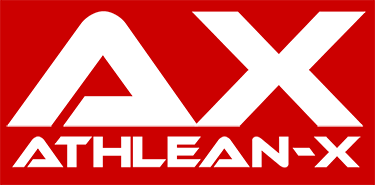
- If you’re serious about maximizing muscle growth, burning calories, increasing growth hormone, and upgrading your fitness level, focus on these six compound exercises. They’re not just common gym moves—they’re the core of a powerful workout routine that delivers real results.
- Overhead Press (Push Vertical): A must for building shoulder and tricep strength, whether standing or seated. Drive the bar overhead with hands under shoulders, maintaining a full range of motion for maximum upper body power.
- Bench Press (Push Horizontal): The classic chest builder. On a flat bench or with an incline, keep your elbows at a 30-degree angle and your hands just over shoulder width to hit your chest, shoulders, and triceps.
- Barbell Row (Pull Row): Engage your back, biceps, and core by pulling the bar toward your belly button with hands under shoulders. This is a staple for any serious muscle-building plan.
- Pull-Up (Pull Vertical): The ultimate strength test. Use a standard or multi-grip pull-up bar to hit your back, shoulders, and biceps. Variations like mixed-grip or negatives can help you push your limits.
- Squat (Lower Body Anterior Chain): The king of lower body exercises, targeting quads, glutes, and hamstrings. Keep hips with knees at a 90-degree angle to maximize the benefits.
- Deadlift (Lower Body Posterior Chain): The full-body strength builder, focusing on hamstrings, glutes, and lower back. A neutral spine and hands under shoulders are key to making every rep count.
- Skipping any of these common exercises is a fitness faux pas—they’re essential for building strength, optimizing calories per exercise, and pushing your body from head to heels to its full potential.
COMPOUND EXERCISES FAQS
You’ve probably heard about the "Big 5" compound exercises, but I’d argue there’s actually a “Big 6” that everyone should be doing if they want to maximize their muscle growth, energy expenditure, and overall fitness level.
These aren’t just big-name exercises; they’re the foundation of an entire fitness routine that delivers the biggest fitness bang for your buck.
Here’s the lineup based on functional movement patterns:
Push (Vertical): Overhead Press – Using classic gym moves like this works your shoulders and triceps, with your arms under shoulders and pressing to a full overhead position. It’s a must for building upper body strength, whether you’re standing or seated.
Push (Horizontal): Bench Press – The Bench Press, whether on a flat workout bench or with an incline push-up variation, targets your chest, shoulders, and triceps. With hands over shoulder width and 90-degree angles at the elbows, this exercise is essential for chest day workouts.
Pull (Row): Barbell Row – The Barbell Row, with hands about shoulder width apart and pulling toward your belly button, activates your back muscles, biceps, and core. This exercise ensures you’re hitting your full-body muscle potential, making it a staple in any Muscle-Building Workout Plan.
Pull (Vertical): Pull-Up – Using a multi-grip pull-up bar or a standard bar, Pull-Ups work your back, shoulders, and biceps. Whether you’re using a mixed-grip pull-up or a negative pull-up technique, this exercise should be in your routine for real life functional strength.
Lower Body (Anterior Chain): Squat – Barbell Squats target the quads, glutes, and hamstrings. Ensure your knees stay soft and aligned with your hips with knees at a 90-degree angle to get the full benefits of this heavy compound lift.
Lower Body (Posterior Chain): Deadlift – The Deadlift is one of those full-body moves that hits the posterior chain, especially the hamstrings, glutes, and lower back. Perfecting your form with hands about shoulder width and a neutral spine ensures you’re reaping the full muscle-building and energy output benefits.
Incorporating all six into your workout schedule not only enhances your performance but also optimizes calories during workouts and promotes muscle hypertrophy through multi-joint moves.
If you’re skipping any of these, you’re leaving gains on the table and missing out on the full benefits of compound exercises.
When it comes to breaking down the classifications of exercises, the difference between simple (or isolation) and compound exercises is pretty straightforward.
Simple exercises target a single muscle group at a time. Think of moves like a bicep preacher curl or leg extension—you’re focusing on one joint and one muscle, isolating that movement for maximum tension on the muscle closest to the joint.
These exercises can be great for targeting specific muscles, especially if you have movement restrictions or need to focus on a particular area due to injury or physical therapy.
However, because they only involve one joint, the calories per exercise and energy output are lower compared to compound movements.
Compound exercises, on the other hand, are your multi-joint, or compound, exercises. These are the heavy hitters like Barbell Squats, Deadlifts, and Pull-Ups that involve multiple muscle groups and joints working together.
The benefit of compound exercises is that they mimic everyday movements, improve neuromuscular coordination, and boost your overall strength and muscle growth.
They also burn more calories per exercise, making them a staple in any muscle-building workout plan or functional workout.
For example, a Reverse Lunge with dumbbells at shoulder height engages your quads, glutes, hamstrings, and core all at once. You move your leg into lunge positioning, but your arms, core, and legs are all working together to stabilize and execute the move, making it a full-body, functional exercise.
This is in contrast to a simple Leg Extension, which isolates the quads with minimal involvement from other muscles.
Incorporating both into your workout schedule is key.
Compound exercises should form the foundation of your routine because of their efficiency and the benefits of compound exercises for building overall strength and improvements in coordination. Simple exercises are like the icing on the cake—great for fine-tuning and targeting specific muscles once the big lifts are done.
So, you’re fired up about your workouts and want to know if you can hit those compound exercises every single day?
I gening program because they give you the most bang for your buck, hitting multiple muscle groups, improvint it—compound moves like the barbell Back Squat, Deadlift, and Pull-Ups are the backbone of any solid traig intramuscular coordination, and cranking up your energy output. But here’s the deal: more isn’t always better.
While compound exercises are excellent movements that recruit a lot of muscle fibers—from your biceps muscle to your glute squeeze—doing them every day without proper rest can lead to your movement slowly breaking down and an increased risk of injury.
Your body needs time to recover, rebuild, and grow stronger. Overloading your muscles with heavy compound lifts every day without giving them time to repair can actually backfire, leading to overtraining and putting you on the fast track to burnout or injury.
Instead of hitting compound exercises daily, consider a safe workout schedule that includes rest days and alternates between heavy lifting and lighter, more functional workouts.
A smart approach would be to alternate between upper and lower body compound movements—say, doing Bodyweight Squats one day and focusing on Overhead Presses or Barbell Rows the next. This way, you’re giving each muscle group ample time to recover while still making gains.
And don’t forget about integrating isolated movements or bodyweight exercises like a plank position or Decline Push-Ups on those lighter days to keep your body moving without overloading it.
These moves can help with muscle balance, flexibility, and even injury prevention, which is crucial for long-term success. The goal is to create a complete workout plan that not only pushes you but also allows you to recover and progress safely.
Bottom line: Listen to your body, and if you’re serious about long-term gains, build in those rest days. Trust me, even the best fitness professionals and exercise experts will tell you that recovery is where the real growth happens.
Here’s the deal—compound exercises are the foundation of any great training program.
They’re efficient, burning more calories per exercise compared to isolation moves and hitting multiple muscle groups in one shot.
These excellent movements are essential for building strength and improving coordination because they engage the entire body, from head to heels. So, can you get away with just doing compound exercises?
Technically, yes. But there’s more to the story.
While focusing on compound lifts is great, you’re missing out if you skip isolation moves. Why?
Because isolation exercises target the muscle closest to the joint, helping you address weaknesses or movement restrictions that compound exercises might not fully cover. For example, if your left knee is lagging behind your right, adding some creative moves like Leg Extensions or Hamstring Curls can balance things out. This is where a good trainer or exercise physiologist can help you build a more rounded program.
Isolation moves also come into play for aesthetics.
Want that peak on your biceps? You’ll need to throw in some Biceps Curls or a Bicep Preacher Curl. And let’s not forget about grip workouts—focusing on your grip strength with an underhand grip or multi-grip pull-up bar will improve your performance in compound lifts like Deadlifts.
Another point to consider: Compound exercises are heavy hitters, but they can lead to overuse injuries if not balanced with recovery or isolation moves. Incorporating bodyweight exercises or using an exercise ball for stability work can help keep your body in position and maintain overall movement efficiency.
So, while it’s okay to focus on compound exercises, the most effective entire workouts will include a mix of both compound and isolation movements.
It’s all about balance.
Compound exercises should be the star of your show, but don’t neglect those supporting actors that help you perform at your best, from calories burned to muscle growth.
REFERENCES
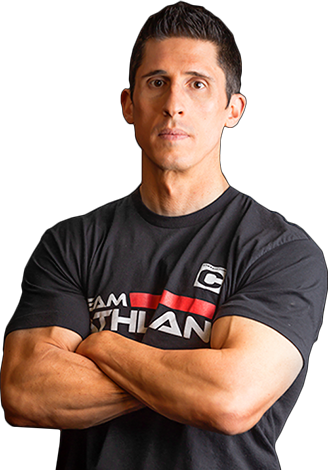
Jeff Cavaliere M.S.P.T, CSCS
Jeff Cavaliere is a Physical Therapist, Strength Coach and creator of the ATHLEAN-X Training Programs and ATHLEAN-Rx Supplements. He has a Masters in Physical Therapy (MSPT) and has worked as Head Physical Therapist for the New York Mets, as well as training many elite professional athletes in Major League Baseball, NFL, MMA and professional wrestling. His programs produce “next level” achievements in muscle size, strength and performance for professional athletes and anyone looking to build a muscular athletic physique.
